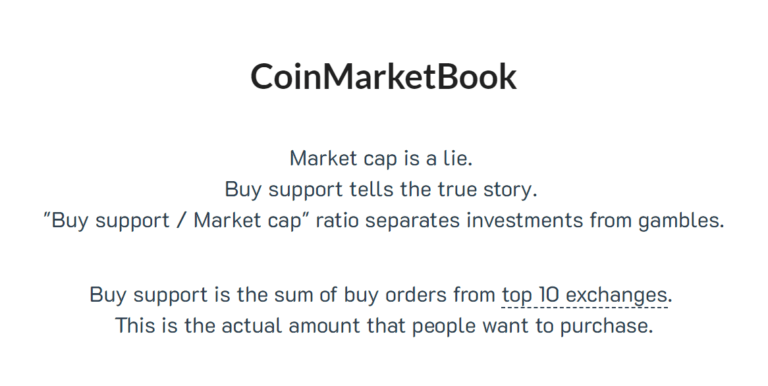A newly launched website claims to show how much buy support is holding up the price of a number of cryptocurrencies.
In the cryptocurrency market, most commentators use market capitalization as a metric of how large a cryptocurrency is. Market capitalization is a simple calculation: current price multiplied by total supply. This calculation is the easiest way to compare the size of different cryptocurrencies, but is it that meaningful?
CoinMarketBook.cc was launched in order to bring a new metric to the market: buy support. The headline on their website is:
“Market cap is a lie. Buy support tells the true story.”
The basis of their website is simple. CoinMarketBook starts by calculating market cap. Then, the site calculates “buy support.” From their website:
“Buy support is the sum of buy orders from top 10 exchanges. This is the actual amount that people want to purchase.”
The exchanges used are: BitMEX, Binance, Bithumb, Bitfinex, OKEx, Huobi, Bittrex, Poloniex, Kucoin, Cryptopia.
The ‘buy support’ metric has been praised by some analysts as users can measure how many people are actually looking to buy the cryptocurrency, indicating real value and demand. However, it’s hard to compare buy support across cryptocurrencies that have different market caps. Bitcoin and dogecoin can’t be measured side-by-side, due to their size. That’s where support/cap comes into play.
Once buy support is summed, CoinMarketBook calculates “buy support per market cap,” as a metric of how much liquidity is available on the market as compared to the market cap of the coin, expressed as a percent. The results might surprise you:
- BTC – 1,816%
- ETH – 27.89%
- HOT – 3.02%
As shown, Bitcoin has massive buy support. There’s actually more buy support for Bitcoin then its actual market cap.
Oneexplanation for this is: margin trading. BitMEX, OKEx, Bitfinex, and Huobi all offer margin trading for Bitcoin. This means users can leverage more money than they actually own in order to trade Bitcoin, which inflates BTC’s support figures.
Going down the list, support/cap falls off a cliff after Bitcoin. Outside of the top 3 (listed above), there are no cryptocurrencies with more than 2% support/cap.
Even large cryptocurrencies like EOS, whose market cap is $5B, only has $46M buy support, giving it a support/cap ratio of 0.87%.
What does this mean for investors?
Simply put – buy support is a measure for how much money will support your cryptocurrency’s price from crashing.
This tool suggests that BTC is the strongest investment vehicle on the market, thanks to all of its buy support. However, some people do not agree with CoinMarketBook’s calculations.
CoinMarketBook Criticism
Despite appearing useful, traders have brought attention to flaws in CoinMarketBook’s metrics.
Sylvain Ribes explained on Twitter that:
Assessing liquidity by looking at the full buy-side orderbook is very dumb. Deep public liquidity is 100% irrelevant. Why? ‘cause most ppl wanting to buy, say, 10% below current price will not lock their monies on exchanges. They’ll wait until the price has dropped 9% first.
To remedy this, Sylvain put together his own liquidity figures. To do this, he “measured how much money was on offer within 2% of the last price point, buy-side and sell-side.”
Then, he divided by the market cap to create a liquidity to market cap ratio, then compared it to BTC. As shown below, altcoins such as ETH, LTC, and even BCH actually have more liquidity using this measure.
8/ Actually if you were to, like the abovementioned link, naively look at the liquidity-to-marketcap ratio, you’d find that Bitcoin does not fare very well compared to other assets. Here it is, normalized for a few of the top assets. pic.twitter.com/YXH9cLv0k2
— Sylvain Ribes (@ArtPlaie) October 8, 2018
This measure seems to be much more reliable. An explanation for CoinMarketBook’s deep BTC liquidity is that there’s billions of dollars of bids at insanely low prices, like $100, that ever expect to be filled. Sylvain’s calculations removes these “stink bids” in order to focus on what’s available close to the current price of the crypto-asset.









